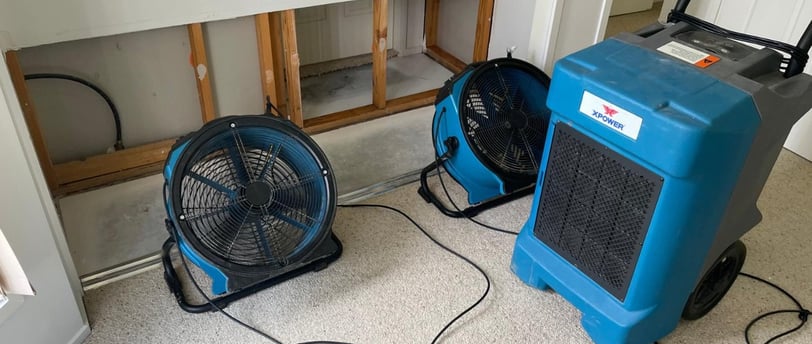Mastering the Art of Structural Drying: A Comprehensive Guide for Restoration Specialists
Structural Drying Procedures
11/29/20233 min read


Introduction:
Water damage to structures can be a formidable challenge, and effective structural drying is crucial for preventing further damage and restoring a property to its pre-loss condition. In this comprehensive guide, we will delve into the intricacies of structural drying procedures, exploring the importance of a systematic approach and the advanced techniques employed by restoration specialists.
Section 1: The Significance of Structural Drying
1.1 Immediate Action for Mitigation
When structures are exposed to water, time is of the essence. Swift structural drying is essential to mitigate the impact of water damage, prevent mold growth, and salvage materials that may otherwise be compromised.
1.2 Preventing Secondary Damage
Proper structural drying not only addresses the visible signs of water damage but also prevents secondary damage. This includes potential structural deterioration, warping, and the onset of mold that can occur in the aftermath of water intrusion.
Section 2: Assessing the Extent of Water Damage
2.1 Professional Inspection
Engage the services of certified water damage restoration specialists for a thorough inspection. Specialists utilize moisture meters, thermal imaging, and other advanced tools to assess the extent of water damage and develop a tailored structural drying plan.
2.2 Categorizing Water Damage
Categorize water damage based on industry standards (clean water, grey water, black water). Different categories require specific structural drying procedures to ensure a safe and effective restoration process.
Section 3: Water Extraction Preceding Structural Drying
3.1 Swift Water Removal
Before embarking on structural drying, swift water extraction is paramount. Industrial-grade pumps, wet/dry vacuums, and other extraction equipment are used to remove standing water, setting the stage for the subsequent drying procedures.
3.2 Prioritizing High-Risk Areas
Focus on extracting water from high-risk areas first, such as basements or areas with electrical systems. Prioritizing high-risk zones minimizes potential hazards and accelerates the overall structural drying process.
Section 4: The Fundamentals of Structural Drying
4.1 Establishing Drying Goals
Setting specific drying goals is a foundational step in structural drying procedures. Restoration specialists use moisture meters to determine acceptable moisture levels, ensuring materials are thoroughly dried.
4.2 Controlled Evaporation
Structural drying relies on controlled evaporation. Airflow is strategically directed to facilitate the evaporation of moisture from wet materials, expediting the drying process.
Section 5: Advanced Structural Drying Equipment
5.1 High-Capacity Dehumidifiers
Industrial-grade dehumidifiers are deployed to extract moisture from the air. These high-capacity units create optimal conditions for efficient and thorough structural drying.
5.2 Air Movers
Powerful air movers are strategically placed to enhance ventilation. Proper airflow is essential for drying out walls, floors, and other structural elements efficiently.
5.3 Injectidry Systems
In situations where water has infiltrated hidden spaces, such as wall cavities or subflooring, Injectidry systems are employed. These systems use targeted airflow to reach concealed moisture and facilitate drying.
Section 6: Monitoring the Drying Process
6.1 Real-Time Moisture Monitoring
Restoration specialists utilize moisture meters and other monitoring tools to assess the progress of the drying process in real-time. This data-driven approach allows for adjustments to the structural drying plan as needed.
6.2 Infrared Thermography
Infrared thermography is employed for comprehensive moisture detection. It identifies temperature variations associated with moisture, helping restoration specialists pinpoint hidden pockets of dampness that may not be visible.
Section 7: Addressing Hidden Moisture
7.1 The Challenge of Hidden Pockets
Water can infiltrate hidden pockets within walls, ceilings, and floors. Advanced techniques, including infrared thermography and moisture meters, are utilized to identify and address hidden moisture during structural drying.
7.2 Careful Removal of Damaged Materials
Materials that cannot be salvaged are carefully removed to expose hidden moisture and facilitate more effective drying. This may include damaged drywall, insulation, and other compromised materials.
Section 8: Post-Drying Assessments
8.1 Verifying Dryness
Thoroughly assessing the dryness of materials is essential before concluding the structural drying process. Restoration specialists use moisture meters and visual inspections to ensure that optimal dryness is achieved.
8.2 Addressing Lingering Odors
In some cases, water damage can lead to persistent odors. Restoration specialists may employ air scrubbers or other odor elimination techniques to ensure the space is not only dry but also free from unpleasant smells.
Section 9: Professional Expertise and Training
9.1 Certified Water Damage Restoration Specialists
Engaging certified water damage restoration specialists ensures that structural drying procedures are applied with precision. Specialists undergo rigorous training to stay abreast of the latest technologies and techniques in the field.
9.2 Tailored Restoration Plans
Professionals develop tailored restoration plans based on the specific circumstances of each water damage incident. This personalized approach ensures that structural drying efforts seamlessly integrate with comprehensive restoration strategies.
Conclusion:
Structural drying is a meticulous and systematic process that requires a combination of expertise, advanced equipment, and a strategic approach. By understanding the importance of swift action, employing advanced drying techniques, and utilizing state-of-the-art equipment, restoration specialists can navigate the challenges of water damage, ensuring thorough and effective structural drying. In the hands of certified professionals, structural drying becomes a cornerstone in the restoration journey, paving the way for properties to be reclaimed and restored to their optimal condition.
A-Z Dryout
3260 N Hayden Rd STE 210 Scottsdale. Arizona 85251
(480) 617-0978
azdryout@gmail.com
